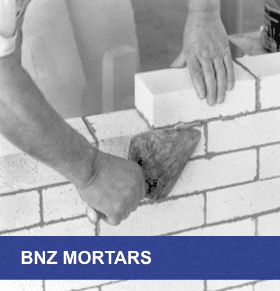Mortar
The compositions and methods of preparation of all mortars have been developed through extensive laboratory investigations to develop the particular combination of properties each bonding mortar should possess. Among the factors included are workability, plasticity, water retention, drying and firing shrinkages, chemical composition, refractoriness, bonding strength, vitrification and resistance to chemical attack.
Bonding Mortars Plant Location
191 Front Street
Zelienople, PA 16063
Phone: 724-452-8650 or 800-955-8650
FAX: 724-452-1346
Typical Applications
- They bond the brickwork into a solid unit with greater resistance to mechanical and thermal shocks and stresses.
- They provide a cushion between the slightly irregular surfaces of the brick to provide a firm bearing for each course.
- They provide resistance to infiltration of air or hot gases.
- They retard penetration of slag and molten metal into the joints.
Available Types
Air Setting Mortars
Wet Air Setting Mortars
A highly refractory mortar which possesses high water retention properties. It is especially designed for laying insulating fire brick and is also used for super duty and high alumina dense refractory brick. It is dark gray in color. Temperature to 3000°F. It is furnished in a consistency suitable for shallow patching or trowelling. For a dipping consistency, add approximately 5 qts. of water to 100 lbs. of the as-received Blakbond. Blakbond is a good choice for a single mortar on jobs involving a majority of insulating fire brick and a few dense fire brick.
No. 2986.
A highly refractory mortar very similar to Blakbond, but gray to tan in color. Temperature to 3000°F.
![]() [download SDS]
[download SDS]
Super Blakbond
An air-setting mortar for general purpose plant use. It has greater air-setting strength than Blakbond or No. 2986. It is good for insulating fire brick where greater bond strength is desired, and can also be used for dense fire brick. Super Blakbond is particularly good for deep patching. It is also used for coating over industrial boiler tubes to level the surface and for shallow patching. The overall excellent properties of Super Blakbond make it ideal for the one mortar to carry in plant inventory. Temperature to 3000°F. An excellent choice for the one mortar on a job involving dense fire brick and insulating fire brick.
![]() [download SDS]
[download SDS]
No. 20.
An air-setting mortar, gray in color, for use where extra hard air-set strength is desired. It is not recommended for laying insulating fire brick. Used up to 2700°F for setting hard brick with a rubbed joint and for washcoating hard brick. When desired to use old fire brick as a patching material or monolithic fill, No. 20 is thinned with water and the crushed brick added. Note: Coating IFB is rarely advisable.
![]() [download SDS]
[download SDS]
Please discuss with a BNZ Representative if this is being considered.
Standard Sizes
All wet mortars are available in 50# pails and 100# and 200# drums. Additionally, Blakbond and No. 20 mortars are available in 15# cans.
Storage and Use
Wet mortars should generally be used within one year of receipt. If a wet mortar becomes frozen, it can normally be remixed and used, after being slowly returned to approximately 70°F by placement in a warm storage area. Storage of wet mortars should be in a cool area to minimize the potential of premature hardening.
Bags of dry mortar should be kept in protected, low humidity storage areas to assure retention of product qualities.
|
Air Setting |
|||||
| Wet, Ready-Mixed | |||||
| Properties | Blakbond | No. 2986 | Super Blakbond | Zelie No. 20 | |
| Temp. Limit, °F | 3000 | 3000 | 3000 | 2700 | |
| Estimated lbs. to set 1000 | |||||
| 9″ x 41/2″ x 21/2″ brick* | 200 – 400 | 200 – 400 | 200 – 400 | 200 – 400 | |
| Modulus of Rupture psi Mortar |
4200 | 4000 | 6100 | 4700 | |
| Modulus of Rupture psi Dipped Joint, ASTM C 198 |
375 | 525 | 575 | – | |
| Linear Shrinkage, %, @ 212°F | 4.3 | 5.0 | 4.1 | 5.1 | |
| Refractoriness, | No Flow | – | No Flow | – | |
| ASTM C 199 | @ 3000°F | @ 3000°F | |||
| Chemical Analysis, % | |||||
| Silica – SiO2 | 48.8 | 46.8 | 48.1 | 90.8 | |
| Alumina – Al2O3 | 43.2 | 46.3 | 43.1 | 5.1 | |
| Ferric Oxide – Fe2O3 | 1.2 | 1.5 | 1.6 | – | |
| Titania – TiO2 | 1.5 | 1.1 | 1.4 | – | |
| Calcium Oxide – CaO | 0.3 | 0.2 | 0.3 | – | |
| Magnesium Oxide – MgO | – | – | – | – | |
| K2O | 0.8 | 0.9 | 0.9 | – | |
| Na2O | 2.4 | 2.4 | 2.7 | 3.3 | |
| Misc | – | 0.1 | – | 0.8 | |
| lg Loss | 1.8 | 1.2 | 1.7 | – | |
| Bulk Density of Refractory Mortars | |||||
| As received, pcf | 126 | 129 | 131 | 121 | |
| Troweling, pcf | – | – | – | – | |
| Percent H2O | – | – | – | – | |
| Dipping, pcf | 124 | 126 | 123 | 116 | |
| Percent H2O | 4 | 4 | 7 | 10 | |
| * Amount depends upon thickness of joint and porosity of the brick. | |||||
Disclaimer:


